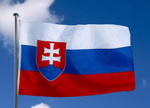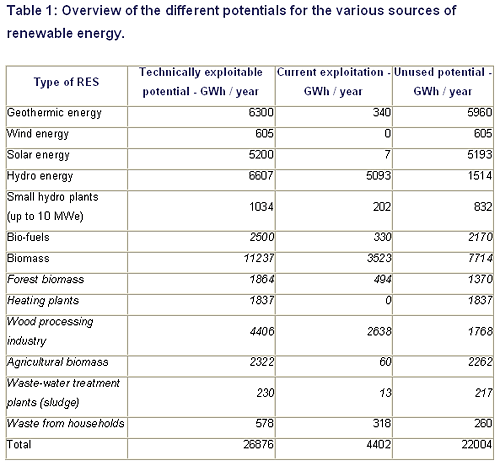Renewable Energy Sector Profile - Slovak Republic
 Slovakia, a landlocked republic in Central Europe with a population of just 5.5 million people, is experiencing some of the best economic growth in Europe. In 2007, the GDP growth was 8.5%.
Slovakia, a landlocked republic in Central Europe with a population of just 5.5 million people, is experiencing some of the best economic growth in Europe. In 2007, the GDP growth was 8.5%. The intention to introduce the Euro currency in January 2009 is a major driving force behind the fiscal policies. Privatization has been practically completed few years ago, with the result that over 96% of industrial and services output is generated by the private sector. A flat corporate tax rate of 19%, a flat income tax rate of 19%, no tax on dividends, together with well educated labour pool and barrier-free access to all regions of Europe, make Slovakia an attractive investment location.
There have been immense infrastructural developments, with municipalities and other government bodies aiding turnkey projects and integration with private companies. The government is placing importance on channelling EU funds toward projects aimed at environmental protection. Concerning greenhouse gas (GHG) emissions, aggregate GHG emissions in Slovakia in 2006 were significantly lower than the base year (1990), falling by approximately 20 percent. This means that the 2008-2012 Kyoto target of an 8 percent reduction from 1990 levels will be successfully met.
While renewable energy sources (RES) are not currently used to a great extent in Slovakia, there is great potential to develop this type of energy. Only 17% of the technically exploitable potential of RES is utilised. It means that there is still a large amount of unused energy, the potential of which is estimated to be 79 215 terajoules (TJ) annually. While the economic potential for heat represents 36.9% of the available potential, that for electricity represents only 27.6%. This trend is also confirmed in terms of the market potential, which is 13.1% for heat, and only 8.6% for power. This can be explained by the relative difficulty of introducing photo-voltaic systems and wind turbines on a large scale.
Besides major local manufacturers, SES Tlmace a.s. (biomass boiler technologies producer) and Thermosolar s.r.o. (top selling solar thermal collectors producer), imported technologies comprise a larger share of new technologies sales in Slovakia, with a 75% - 85% market share. They are mainly arriving from Austria (biomass), Germany (biomass, PV cells, small hydro power plant/SHPP and wind) and Denmark (biomass and geothermal), while solar thermal utilization is covered 95% by domestic production.

BIOMASS
Biomass is one of the most important RES in Slovakia because 41% of the area of the country is forest and 50% is agricultural land. Wood fuel producers such as AVS s.r.o., Lesy SR and many other companies have started to operate on the Slovak market, annually producing 400,000 tons of log wood, 50,000 tons of wood briquettes (17 manufacturers), 60,000 tons of wood pellets (16 manufacturers) and 150,000 tons of wood chips.
There is a project in preparation involving the co-firing of coal with wood biomass for the biggest thermal power plant firing domestic brown coal, Elektrárne Nováky, that has an installed capacity of 518 MWe. In pilot operation, approximately 30% of fired fuel will be replaced by biomass. Several municipal district heating plants have been rebuilt for biomass utilization (wood pellets, wood chips) and some of them were also converted for the combustion of agricultural waste biomass (straw).
WIND ENERGY
The first wind mill park (Wind Park Cerova) has been opened in western Slovakia by the Austrian/Slovak joint venture company, Green Energy, with an installed capacity of 6,5 MW electric and it is planned to open another two sides with over capacity of approximately 16 MWe. There are currently only three wind farms in Slovakia located at Senica/Cerova (4x0.6MW), Myjava (1x0.5MW) and Skalite (4x0.5MW). For the future, there are plans to consider a further 25 wind-power projects generating in total 300-400 MW, using 0,5 - 2 MW aerogenerator units, most of them located in western Slovakia.
SOLAR ENERGY
Despite Thermosolar’s large local manufacturing facility supplying solar thermal panels to many European countries, use of solar energy is quite low. Potential exists in two groups of buildings: newly built houses or homes where the heating system is at the end of its life cycle and it is necessary to invest in a new heating system. The design of newly constructed buildings already implements passive solar systems, e.g. double glazing, orientation of glass surfaces aimed at minimising thermal losses and increasing solar thermal gains.
The potential for solar thermal collectors in public buildings is mainly related to the preparation of domestic hot water, particularly in schools, healthcare facilities, the hotel sector and sport centres. Attractive possibilities could be large-scale solar thermal systems, either as stand-alone installations or combined with a district heating plant using another energy source (e.g. biomass or natural gas), but currently no such systems are in place in Slovakia. Thermal solar installations for family houses are moderately cost-effective, with a payback period of 20-24 years for a life time of 25 years.
Therefore, the economic potential for such installations is considered to be only slightly positive, at 216 TJ/year. Solar thermal installations in apartment buildings are rather cost effective, with a payback period of around 9 years. It is assumed that 10% of the buildings using gas and 40% of those using coal or fuel oil could be potential solar energy users when the heating system is replaced, or when new buildings are constructed. This means approximately 80,000 flats could be using solar collectors for domestic hot water. This corresponds with an energy consumption of 749 TJ/year. An estimated 5% of non-residential buildings could adopt solar collectors for the preparation of hot water, representing an energy consumption of 3,595 TJ/year.
As the electric power grid covers over 98% of the country, it is more likely that photovoltaic (PV) technology will be locally installed - not to replace existent electricity sources, but rather to power some remote equipment in out-of-grid areas (environmental monitoring, security and information devices and lighting).
GEOTHERMAL ENERGY
The potential of geothermal energy is quite great. Geothermal waters in the Slovak Republic are being utilised in 35 locations offering an aggregate heating capacity of 75 MW and generation of 1,218 TJ/y to municipal heating stations, swimming pools and greenhouses. The country has 25 prospective areas of geothermal resources with temperatures up to 150 degrees Celsius and in depths up to 5,000 m. The most abundant of them is the Košice basin with a potential of about 300 MW, where eight planned pairs of wells, with an output of about 100 MWt to be used for central heating of the city of Košice, have entered the first phase implementation. Efficacy of the use of low -temperature geothermal waters can be enhanced through the application of heat pumps. Such projects were implemented, for example, at two spa resorts (40 kW and 2 x 450 kW).
SMALL HYDROPOWER PLANTS (SHPP)
The total technical potential for hydropower is estimated at 6,607 GWh/year (23,785 TJ/year). This represents nearly 24% of the technical potential for all RES in the Slovak Republic. This potential decreases to 1,034 GWh/year (3,722 TJ/year) when only small hydroelectric plants are taken into account. This represents 4.6% of the total potential for RES. 19.5% of this potential is presently exploited, leaving an available amount of 831 GWh/year (2,995 TJ/year). There are overall 200 locations which have been selected as the building sites for small hydropower plants on the rivers Danube, Vah, Hron, Bodrog and Hornad which could bring a total installed capacity of 93 MW.
BIOFUELS
Slovakia has caught up with European trends and requirements with the increased production and use of bio-components in motor fuels such as bioethanol (and ETBE/ethyl tertiary butyl ether) made from corn, and methylester (MERO/methyl ester of rapeseed/canola oil). Gasoline and diesel fuel produced at the Slovnaft refinery contain up to 5 percent of these components, which is in line with EU requirements aimed at reducing carbon-dioxide emissions. According to an EC decision, all motor fuels will have to contain 10 percent of these bio-components by 2010. Palma-Tumys from Senkvice near Bratislava is the biggest producer of methylester (30,000 ton/y), while Enviral in Leopoldov is the main source of bioethanol (120,000 ton/y).
Market and Sector Challenges (Strengths and Weaknesses)
Slovakia’s accession to the EU in 2004 brought with it the implementation of a series of environmental programs and policies, all geared toward conformity with EU standards. A long-term goal in the area of renewable energy sources is to attain a level comparable with the majority of EU countries. There is an increased pace in the development of renewable energy sources and this trend is expected to continue in the future. By 2010, the RES share in Slovakia will be up to 6-10%. However, the fulfilment of this demanding program requires a co-ordinated approach in the creation and implementation of necessary systematic measures with respect to energy prices, energy taxes, relevant legislation, ecology, and the power generation industry.
Specific incentives for implementation of RES projects in Slovakia include the following -
- Environmental protection has become a matter of increasing public concern.
- Relevant legislation includes an obligation to purchase and transmit the offered electric energy (from secondary and renewable resources) for economically acceptable prices.
- Financial support is available from European Funds for rational use of energy and RES utilization. *All Slovak regions (except the Bratislava Region, which has attained more than 75% of the GDP level in the EU) are eligible to apply for grants and subsidies from EU Structural Funds (both public and private sector).
Specific barriers to the implementation of RES projects in Slovakia include the following -
- Current consumer prices for conventional energy sources are relatively acceptable; however, prices are expected to gradually increase.
- The comfort of natural gas for heating.
- The present high price of equipment for RES installations, combined with the long payback period.
Sub-Sector Identification and Opportunities
Biomass: There has been an increase in the number of wood/biomass-fired units for single family houses systems (<25 kW). Obsolete coal and gas-fired boilers have been replaced by biomass boilers in district heating systems. Large central biomass boilers (for wood chips) have been installed for space heating and domestic hot water heating in community buildings.
Landfill gas: Landfill gas is being utilized in municipalities and cities.
Small Hydro Power Plants - A series of micro hydropower plants have been built on the Vah and Hron rivers.
Heat pumps: Heat pumps for single family houses have been installed in several Slovak municipalities.
Geothermal energy: A district heating system using geothermal energy has been installed. Small heating systems using geothermal energy in touristic cities in south-western and north-central Slovakia are being developed.
Excerpts from: Environmental Industries Sector Profile - Slovak Republic Sub-sector: Renewable Energy, DFAIT, October 2007; available here.
Canadian Embassy Office in Bratislava
Contact: Mr. Milan Harustiak,
Trade Commissioner
E-Mail: milan.harustiak@international.gc.ca
Internet: http://www.canada.cz
You can return to the main Market News page, or press the Back button on your browser.

